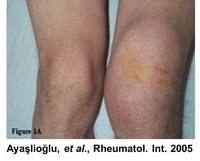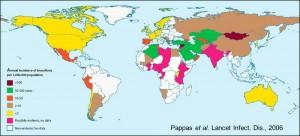
Brucellosis is an infectious disease caused by bacterial pathogen Brucella. Brucellosis in humans most often arises from the ingestion of unpasteurized milk products or raw meat from animals infected with brucellae, which are gram-negative facultative intracellular bacteria. Brucella also poses as an occupational hazard for meat processors, livestock handlers, and veterinarians, as a result of exposure to contaminated meat and blood. Pulmonary disease has been reported in which infection possibly resulted from exposure to contaminated aerosol. Brucella has been weaponized by several countries as a possible biological warfare agent. While not life-threatening in humans, brucellosis can cause disease with relapses of undulating fever and lifelong complications, including arthritis, endocarditis, and possible neurological symptoms, despite antibiotic treatment. In addition, Brucella causes disease and abortion in many of the agricultural animals in the world resulting in wide-spread economic losses.

With over 500,000 new cases annually, brucellosis is one of the most common zoonotic infections worldwide and remains a global health problem in humans, particularly for the Mediterranean rim, Middle East, Central Asia, and U.S. states that border Mexico. Bison and elk in Yellowstone National Park, along with feral swine in the South, are a reservoir of Brucella infection in the United States.
Osteoarticular complications are associated with prolonged illness in humans and are the most common localized manifestation of brucellosis occurring in up to 80% of cases. Currently little is known about the pathogenesis of articular brucellosis. Researchers at MU are investigating the immunologic basis for Brucella-induced osteoarticular pathology. The goal of these studies at LIDR is to identify pathogenic immune responses that can be targeted as a means to augment antibiotic resolution of joint inflammation in osteoarticular brucellosis.
